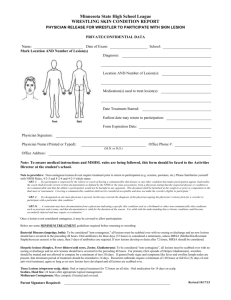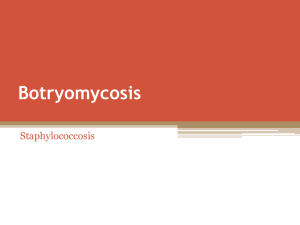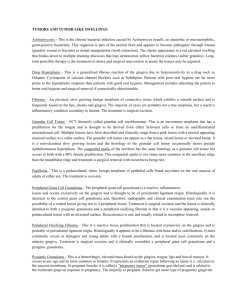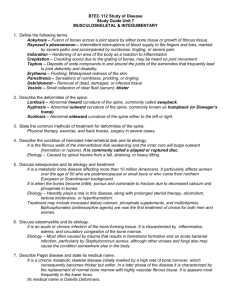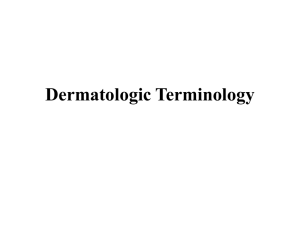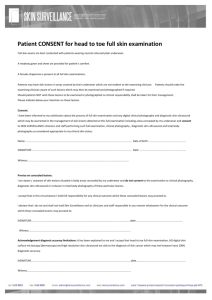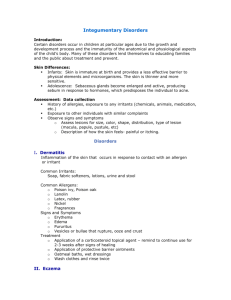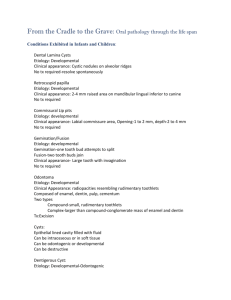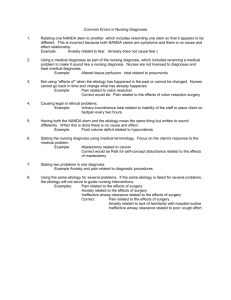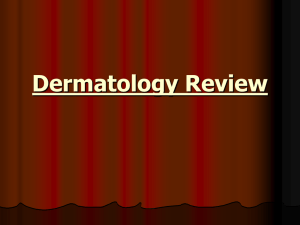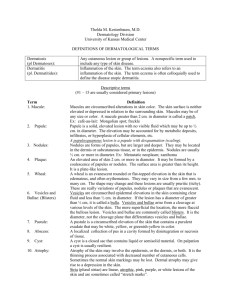outline6580
advertisement
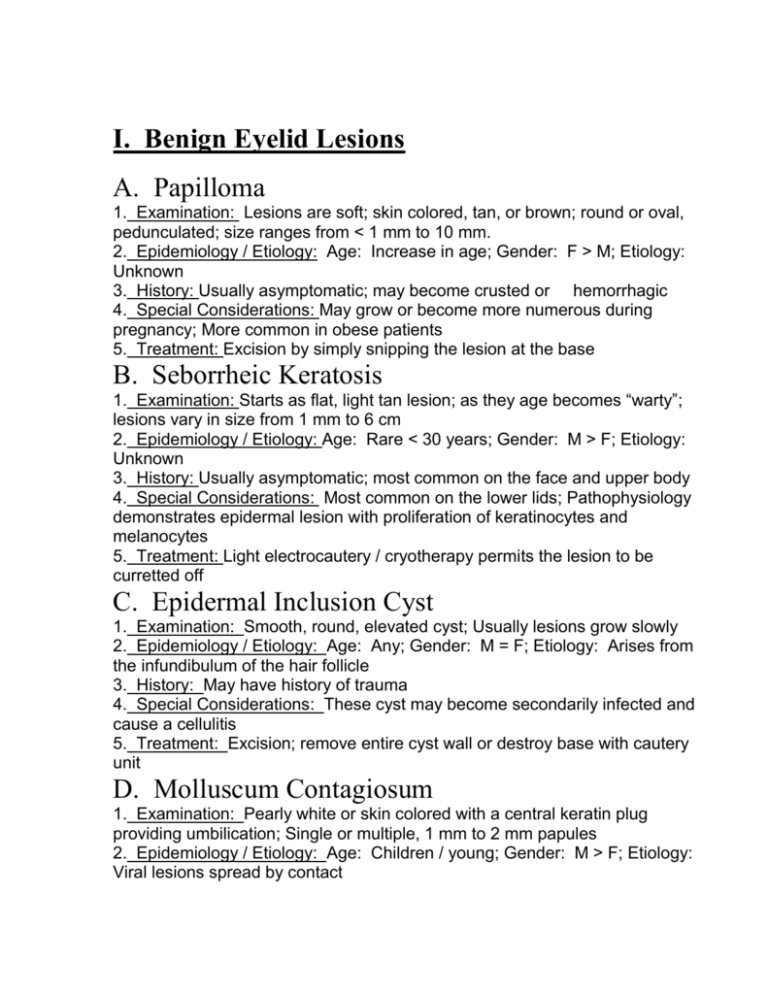
I. Benign Eyelid Lesions A. Papilloma 1. Examination: Lesions are soft; skin colored, tan, or brown; round or oval, pedunculated; size ranges from < 1 mm to 10 mm. 2. Epidemiology / Etiology: Age: Increase in age; Gender: F > M; Etiology: Unknown 3. History: Usually asymptomatic; may become crusted or hemorrhagic 4. Special Considerations: May grow or become more numerous during pregnancy; More common in obese patients 5. Treatment: Excision by simply snipping the lesion at the base B. Seborrheic Keratosis 1. Examination: Starts as flat, light tan lesion; as they age becomes “warty”; lesions vary in size from 1 mm to 6 cm 2. Epidemiology / Etiology: Age: Rare < 30 years; Gender: M > F; Etiology: Unknown 3. History: Usually asymptomatic; most common on the face and upper body 4. Special Considerations: Most common on the lower lids; Pathophysiology demonstrates epidermal lesion with proliferation of keratinocytes and melanocytes 5. Treatment: Light electrocautery / cryotherapy permits the lesion to be curretted off C. Epidermal Inclusion Cyst 1. Examination: Smooth, round, elevated cyst; Usually lesions grow slowly 2. Epidemiology / Etiology: Age: Any; Gender: M = F; Etiology: Arises from the infundibulum of the hair follicle 3. History: May have history of trauma 4. Special Considerations: These cyst may become secondarily infected and cause a cellulitis 5. Treatment: Excision; remove entire cyst wall or destroy base with cautery unit D. Molluscum Contagiosum 1. Examination: Pearly white or skin colored with a central keratin plug providing umbilication; Single or multiple, 1 mm to 2 mm papules 2. Epidemiology / Etiology: Age: Children / young; Gender: M > F; Etiology: Viral lesions spread by contact 3. History: Spontaneously occurring 4. Special Considerations: If located at eyelid margin, may cause follicular conjunctivitis; May cause disfiguring lesions in immunocompromised patients 5. Treatment: Treat core with electrodesiccation or direct excision of lesion E. Syringoma 1. Examination: Skin colored / yellowish, multiple, up to 2 mm; Common on lower eyelids 2. Epidemiology / Etiology: Age: Puberty; Gender: Women; Etiology: Adenoma of the intraepidermal eccrine duct 3. History: Insidious onset 4. Special Considerations: May present elsewhere on face, axillae, umbilicus, upper chest and vulva 5. Treatment: Electrosurgery or direct excision F. Apocrine Hydrocystoma 1. Examination: Cystic lesion near / at lid margin which are translucent; May be multiple lesions 2. Epidemiology / Etiology: Age: Adults; Gender: Equal; Etiology: Cyst formation from gland of Moll 3. History: May slowly enlarge 4. Special Considerations: The lesion is an adenoma of the secretory cells of Moll and not a retention cyst 5. Treatment: Marsupialization of the cyst for superficial lesions; Complete excision for deeper lesions II. Eyelid Inflammation A. Chalazion, Anterior / Retro Tarsal 1. Examination: A firm mass which is not painful to touch; May protrude anterior to tarsal plate, posterior to tarsal plate or both 2. Epidemiology / Etiology: Age: Any; Gender: Equal; Etiology: Obstruction of meibomian glands 3. History: May present as an infection 4. Special Considerations: Chronic, nonresolving or reoccurring chalazia need to be biopsied to rule out carcinoma 5. Treatment: Warm compresses with massage, Intralesional Steroid Injections or Surgical Incision and Curettage B. Hordeolum, External / Internal 1. Examination: Red, swollen, tender eyelid, often with focal area of infection around a gland 2. Epidemiology / Etiology: Age: Any; Gender: Equal; Etiology: Bacterial infection of Zeiss or Meibomian glands 3. History: Sudden onset 4. Special Considerations: If patient is febrile, increase the loading dose of the oral antibiotics; monitor for the development of a chalazion 5. Treatment: Warm compresses with topical antibiotic / steroid ointment for external; Oral antibiotics for internal III. Eyelid Neoplasms A. Actinic Keratosis 1. Examination: Rough, slightly elevated, skin- colored or light brown lesions with hyperkeratotic scale 2. Epidemiology / Etiology: Age: Over age 40; Gender: M > F; Etiology: Sun exposure 3. History: Extensive sun exposure in youth; lesions present for months 4. Special Considerations: It is estimated that one Squamous Cell Carcinoma will develop per 1000 Actinic Keratoses 5. Treatment: Excise nodular lesions / pathological evaluation; Flat lesions with liquid nitrogen or 5% 5-fluorouracil cream B. Lentigo Maligna 1. Examination: Flat, dark brown or black color, sharply defined edges Often appear as a dark “stain” on the skin 2. Epidemiology / Etiology: Age: Median age 65; Gender: M = F; Etiology: Sun exposure 3. History: Exact onset of lesion is usually unclear 4. Special Considerations: This is a premalignant lesion and should be excised because of the chance of development into a melanoma 5. Treatment: Excision with margins sent out for pathological evaluation C. Basal Cell Carcinoma 1. Examination: Round or oval, firm lesions with depressed center; the center may be ulcerated; May present as pigmented lesions, especially in patients with darker skin; Note the pearly edges on the inferior part of the lesion; A cystic lesion can be a Basal Cell Carcinoma: This lesion is larger than most hydrocystomas and has a slightly violaceous hue; Basal Cell Nevus Syndrome: is an autosomal dominant syndrome where the patient develops many Basal Cell Carcinomas all over the face at a very young age 2. Epidemiology / Etiology: Age: Over 40 years; Gender: M > F; Etiology: Sun exposure 3. History: Slowly enlarging lesions in sun-exposed areas. The lesions may bleed 4. Special Considerations: Aggressive treatment of basal cell carcinoma of the medial canthal area is indicated because of risk of orbital extension 5. Treatment: Complete excision with pathological evaluation; Reconstruction of the defect is often completed at the same time D. Squamous Cell Carcinoma 1. Examination: Differentiated lesions are keratinized, firm and hard; undifferentiated lesions are fleshy, granulomatous and soft 2. Epidemiology / Etiology: Age: Over 55 years; Gender: M > F; Etiology: Sun exposure 3. History: Persistent keratotic lesion or plaque that does not resolve after 1 month 4. Special Considerations: Malignant tumor of epithelial keratinocytes; Incidence: 12 per 100,000 white males; 7 per 100,00 white females; 1 per 100,00 blacks 5. Treatment: Complete surgical excision with controlled margins and pathological evaluation E. Sebaceous Adenocarcinoma 1. Examination: Nodular lesion simulating chalazion; unilateral chronic blepharitis; Destructive / ulcerative lesion on the eyelid margin; when the eyelid is everted there is an infiltrative lesion of the tarsal conjunctiva 2. Epidemiology / Etiology: Age: > 50 years; Gender: F > M; Etiology: Arises from meibomian, Zeiss, and sebaceous glands 3. History: Chronic blepharitis or nonresolving chalazion 4. Special Considerations: This lesion is highly malignant and potentially fatal; the “great masquerader” Can have skip areas 5. Treatment: Complete excision with wide controlled margins and pathological evaluation using special lipid stains

